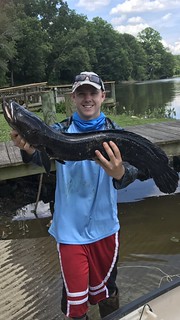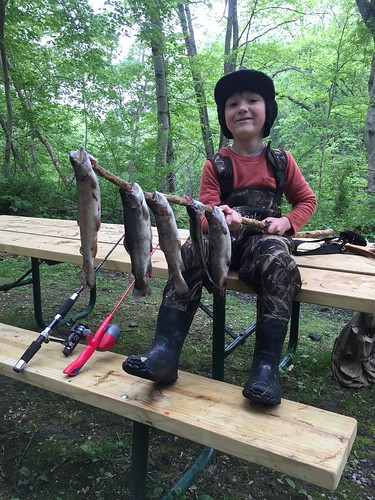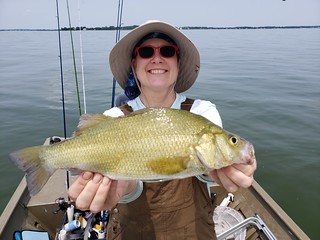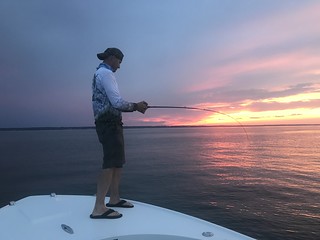Maryland Fishing Report – June 5
There is a special bond between grandparents and their grandchildren, and some children are lucky enough to have a grandpa or grandma to take them fishing. Lothar Weber recently took his 5 year old grandson Dexter trout fishing near Little Falls. Grandpa brought his fly fishing outfit, Dexter dug up his mom’s garden to collect some worms for bait. The results of their trout fishing trip together was described as: Dexter 5, trout and Grandpa 0.
Two more license-free fishing days are scheduled this year on June 8 and July 4. These are perfect opportunities to get someone started on their own fishing adventures!
Chesapeake Bay waters will continue to slowly warm, with mostly cloudy conditions and expected daytime air temperatures in the low to mid 80s and night temperatures in the high 60s. Expect a slight cooling with rains likely early next week. Salinities are still running very low for this time of year — about 10 ppt — near the Virginia state line. In most Maryland bay waters, anglers will find adequate oxygen for gamefish from the surface to bottom. To avoid low oxygen conditions in the deep channel waters from the Bay Bridge down to the state line, avoid fishing deeper than 25 feet. On the east side of the Bay Bridge, near the mouth of the Little Choptank River and Ragged Point, avoid fishing below 15 feet. To see oxygen levels by depth, check our “Don’t fish below this depth” map.
Bay water temperatures have mostly remained stable this week for the upper bay but have slowly increased in the lower bay. For the middle-to-upper bay — from Annapolis north — water temperatures are holding at the low to mid 70s. For the middle-to-lower bay, surface water is holding at the low to mid 70s while the bottom temperatures are stable in the mid-60s. Choptank area water temperatures are rising to the upper 70s. For the Potomac River, at Little Falls and Point Lookout, surface water temperatures also have risen to the upper 70s. Check online for our map of water temperatures by depth.
Expect decent water clarity on Maryland’s portion of the bay mainstem. However, algal blooms are beginning to appear in the upper Patuxent as well as the Bush, Gunpowder, Nanticoke and Wicomico rivers so water clarity is likely to decrease. Expect normal flows from Maryland’s rivers and streams this week. There will be above average tidal currents through Saturday as a result of the recent new moon June 3.
For the full weekly fishing conditions summary and more detailed and up-to-date fishing conditions in your area of the bay, be sure to check out Click Before You Cast. You can now get regular updates on Maryland’s waters and the creatures that call them home sent to your inbox with our new Eyes on the Bay newsletter. Sign up online.
Anglers are once again facing stained conditions and low salinity values this week, due to high flows from the Susquehanna River and local tidal rivers. There are some striped bass to be found, along the traditional steeper channel edges and structure such as bridge piers. All areas of the upper bay, including the Susquehanna River up to the Conowingo Dam and all tidal rivers, are now open to fishing for striped bass.
The bridge piers of the Francis Scott Key Bridge and the Chesapeake Bay Bridge are good places to use large soft plastic jigs near the pier bases. Chunking or live-lining white perch at these bridge piers can also be a good option, just remember that non-offset circle hooks must be used when using live fish for bait or when chumming or chunking.
Trolling along the steep channel edges of Love Point and near the mouth of the Magothy River have been a few of the places striped bass are being found. Umbrella rigs with bucktail or swimshad trailers are popular as well as spoons pulled behind inline weights or planers.
Chumming or chunking has been a good option at Podickory, Love and Swan points. The 30-foot edge at Podickory has been a very popular spot to chum. Reports tell of large numbers of catfish being lured to the chum slicks and providing the bulk of the action, so extra bait is a good idea.
Fishing for white perch is a great option in the tidal rivers of the upper bay. Using a simple bottom rig baited with pieces of bloodworm or grass shrimp is one of the more popular ways to catch them. Casting beetle spins along shoreline structure in the tidal rivers and creeks during the morning and evening hours is a fun way to fish with ultra-light tackle. Old piers, rip rap and fallen tree tops are great places to explore.
The traditional summer and fall striped bass season began June 1 and now anglers can fish wherever they wish to in the tidal rivers or bay, and settle into the familiar limits of two fish at 19 inches to 28 inches, or one fish above and one below 28 inches.
Trolling has been one of the more popular methods of fishing along channel edges. A mix of bucktails dressed with sassy shads, swimshads and spoons tend to fill out most trolling spreads. The bucktails or swimshads are being trolled in tandem or behind umbrella rigs. Spoons are deployed behind inline weights and planers. The traditional channel edges of Hackett’s, Bloody and Thomas points are good places to try, as are Buoy 83 and Breezy Point.
Jigging in these same areas or wherever fish can be found suspended is a fun and productive way to catch striped bass. Using soft plastics in the 6-inch or better sizes with light jig heads is one of the best ways to jig. The channel edges in the bay are always a good place to check but inside Eastern Bay is also worth checking out. There are steep edges off Holicutts Noose, Claiborne and the southeast edge of Bloody Point Bar. At times one might encounter small fish on top chasing bait and there may be some larger striped bass underneath, holding close to the bottom.
Chumming for striped bass is a nice way to relax while anchored up this week. Catfish have been keeping anglers busy though as they tend to horde in on any chum slick in the middle bay. Striped bass are being caught at several of the traditional channel edge locations but catfish can be dominant at times. Remember that non-offset circle hooks are a must when chumming and can be a real asset in regard to quick releases of unwanted catfish. Just keep a good pair of fishing pliers handy to rotate those circle hooks out of the corner of the fish’s jaw.
White perch have been offering plenty of fun fishing opportunities in the tidal rivers and creeks throughout the middle bay region. They can be found along shoreline structure in the mornings and evenings in relatively shallow water. Casting small jigs, beetle spins and spinners near rip rap, old piers or sunken wood are good places to find white perch feeding. Fishing deeper waters over oyster reefs with dropper fly rigs or bottom rigs baited with pieces of bloodworm is another good tactic.
The shallow-water striped bass fishery in the tidal rivers of the middle bay is slow to nonexistent. Now that all areas of the bay are open, forays into traditional shallow water locations have not turned up much in the way of fun topwater action. There are a few small striped bass and large white perch can pick up the slack if you’re rigged for them, but there has not been any good action with larger striped bass. We’ll keep trying — hopefully this fishery will develop soon.
The lower bay offers a wide range of fishing opportunities for striped bass. Chumming has been very popular in the lower Potomac River along the steep channel edge between Piney Point and St. Georges Island. There have been recent reports of a nice grade of striped bass being caught along with large numbers of blue catfish. Those fishing there say to bring plenty of extra bait. There has also been some chumming action near the Middle Grounds and reports of small bluefish moving into the area chum slicks.
Trolling a mix of spoons, bucktails and swimshads along channel edges in the Potomac and Patuxent rivers as well as the shipping channel edges in the bay has been a good tactic. The spoons are being pulled behind inline weights and planers; Drone spoons have been a favorite choice. Bucktails dressed with sassy shads or swimshads are being pulled behind umbrella rigs or in tandem.
Jigging has also been a favored way to fish the lower Potomac and Patuxent rivers, the edges of the shipping channel in the bay as well as the mouths of the tidal rivers on the eastern side of the bay and the cuts through Hoopers Island. Large soft plastics with just enough of a jig head to reach the bottom has been the most popular choice.
Speckled trout are showing up in greater numbers along the marshes and creeks of the lower Eastern Shore. Working soft plastic swimshads along marsh edges, stump fields or bouncing along the bottom in creeks has been a good tactic. There has also been some exciting topwater action in the morning and evening hours for a mix of small striped bass, speckled trout and even an occasional red drum.
A few spot and croaker have been caught recently near Point Lookout and Tangier Sound this week. Pieces of bloodworms on a bottom rig has been standard fare. There are plenty of white perch in the same areas and providing plenty of action. In the Potomac, Patuxent and Nanticoke rivers blue catfish tend to dominate the bottom fishing scene.
Recreational crabbing is moving along at a steady pace with catches improving. Most report that the bulk of the heavier crabs are 5 inches to 5 1/4 inches, with larger 6-inch or better crabs being light. Hopefully those larger crabs will gain some weight in the next week or so. There are a lot small crabs chewing up baits which despite the loss of bait, hold good promise for late-season crabs.
The lower Eastern Shore creeks and tidal rivers have been offering the best catches with a full bushel per outing when trot lining. The middle bay region area catches have been averaging around a half-bushel per outing. Water depths of 5 feet to 10 feet seem to be the sweet spot when laying out trotlines or collapsible crab traps.
The trout streams and rivers of Western Maryland are beginning to take on the summer atmosphere. For the angler that enjoys some peace and plenty of good fishing, it is a perfect match. Fly fishermen who are more interested in catching trout on dry flies rather than filling their creel can enjoy the special trout management areas that are fly fishing only and catch-and-release. Some of the central region trout streams also provide the same type of fishing such as the upper Gunpowder River. There are all kinds of hatches coming off this week — midges in the early morning hours; sulphurs, caddis and mayflies later on in the day.
For those who wish to take some trout home, the delayed harvest trout management areas opened up to a five fish-per-day creel limit on June 1. They are listed in the Maryland Guide to Fishing and Crabbing or you can reference the trout management map site to see where these areas are located.

Jacob Harman recently caught this big northern snakehead in Mattawoman Creek. Photo courtesy of Jacob Harman
Deep Creek Lake is now set in summer vacation mode and this will mean dodging boat traffic for those wishing to fish. One needs to be out early and perhaps you can find a quiet cove. Floating docks are the best place to find largemouth bass loafing under the shade. Pitching a variety of soft plastics under the docks is a great way to hook up. Some docks will also hold smallmouth bass as will sunken wood, rocks and deep grass.
The upper Potomac River is finally settling down but with thunderstorms in the forecast be watchful of river levels. Smallmouth bass tend to be the main target species right now. They can be caught in the shallower areas on topwater lures or shallow running crankbaits during the early morning hours. As the day wears on, targeting the deeper channel edges, submerged ledges and main channel boulders with jigs and small crankbaits is a good bet.
The tidal Potomac River is offering plenty of fishing for largemouth bass this week. The Wilson Bridge piers, rip rap banks and the Spoils are good places to fish topwater, crankbaits and plastic jigs for largemouth bass holding to structure. The grass beds and lily pad fields found in shallower water are the places to hit first thing in the morning with topwater lures such as poppers, frogs and buzzbaits.
Fishing for northern snakeheads is in a slack time right now in the tidal Potomac waters as well as the lower Eastern Shore and other tributaries spread throughout the Chesapeake Bay watershed. No one would ever say northern snakeheads are bad parents — currently they are protecting their young, which can often be seen as a dark mass just under the surface of the water. Some enterprising anglers have taken to dragging buzzbaits through the mass of young northern snakehead fry and enticing the parents to lash out at the offending lure.
As we approach the official beginning of summer later this month, recent hot weather has had a warming effect on freshwater ponds, lakes and tidal rivers. For largemouth bass, the shallow water bite lasts a little longer into the morning but will get shorter and shorter as the month progresses. The classic summer mode for largemouth bass is to hit the shallows at night looking for supper and then retreating to cool shade to loaf the rest of the day. Sounds like a good idea to me.
Hit those shallow grass beds with topwater lures in the early morning or late evening hours. Buzzbaits, frogs, lipless crankbaits tend to be the standard. Does anyone use some of the old baits like Hula poppers and Jitterbugs? Once the sun is high in the sky, flip soft plastics under docks or overhanging bushes, or drop them down through thick grass.
Chain pickerel will be parked somewhere back in shaded grass waiting for dinner to come to them and dreaming of the cooler months. Bluegills can provide plenty of fun action with the classic bait and bobber rig. If you own a fly rod or are thinking of giving it a try, casting small rubber-legged ants or bugs with a light fly rod can be a blast on a quiet summer evening.
Surf fishing along the Ocean City and Assateague beaches continues to provide some fun action although some of the participants are changing. The black drum seem to have parted and the large migrating striped bass may have passed through our waters on their way to New England. There are plenty of bluefish to be caught though. Cut mullet, finger mullet and cut menhaden baits seem to be the most popular way to fish. Those looking for a little more exercise have been casting metal and catching bluefish also. Kingfish are being caught on pieces of bloodworms, blowfish on squid or clams.
At the inlet bluefish continue to move in and out with the tides. They seem to favor an incoming tide for their forays into the inlet and back bay waters. Casting Got Cha lures, bucktails, metal or drifting cut bait are the most popular ways to catch them. There are still tautog to be caught in and around the inlet on pieces of green crab or sand fleas. Flounder are ever present in the inlet and can be caught by casting white soft plastic mullet or shrimp type baits and bouncing them along as the current sweeps them by.
Flounder tend to be the big draw in the back bay channels and for good reason — there are good numbers of them and drifting along bouncing a bait along the bottom is a fun way to spend a day. Always be careful of large boats that are using the channels to get back to their marinas. The classic squid or minnow baits or white soft plastic baits have been working well. Slow trolling also works in areas with little current. Bluefish are roaming the back bay areas near the inlet and can be caught by casting swimshads or as incidental catches while flounder fishing.
Outside the inlet, bluefish are being caught near some of the various shoal areas by trolling spoons behind inline weights or planers. The bluefish are also being found farther offshore near the 30-fathom contours. Skipjack tuna, king mackerel and even a white marlin have also been caught near some of the 30-fathom lumps. A couple of mako and thresher sharks have been caught near some of the same lumps.
Fishing for sea bass has been good at the offshore wreck and reef sites, with limit catches possible. Farther offshore near the canyons, a variety of offshore species are starting to appear. A few white marlin have been caught recently in the Washington Canyon and the 30-fathom lump known as the Hot Dog. Dolphin are being caught in the Washington, Poormans and Baltimore canyons along with yellowfin and Bluefin tuna.
Offshore anglers are reminded to turn in catch cards for bluefin tuna, billfish and sharks.
“… Left to his own natural instincts and his common sense, any man of reasonable intelligence and sensibility is likely to favor bottom fishing above all other forms. ” — Louis D. Rubin Jr.
Maryland Fishing Report is written and compiled by Keith Lockwood, Maryland Department of Natural Resources fisheries biologist.
Click Before You Cast is written by Tidewater Ecosystem Assessment Director Tom Parham.
This report is now available on your Amazon Echo device — just ask Alexa to “open Maryland Fishing Report.”





 1-888-373-7888
1-888-373-7888 233733
233733